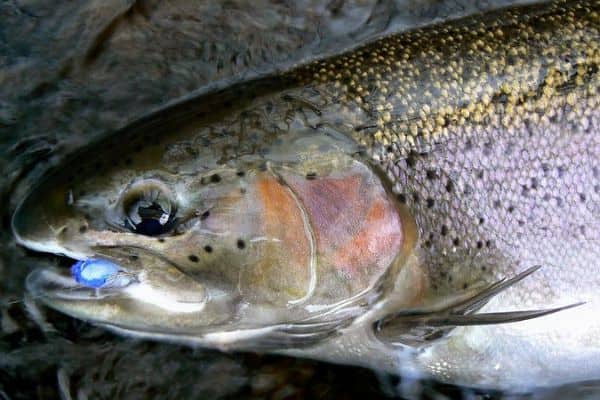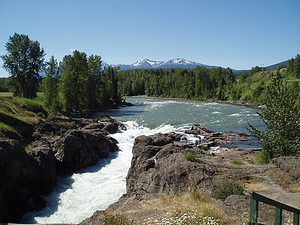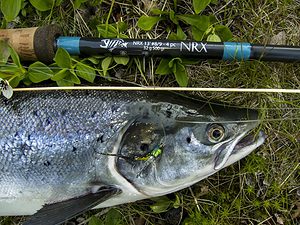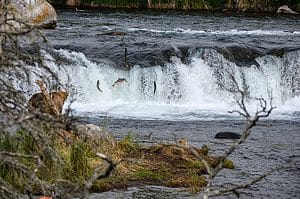Disclosure: Some posts contain affiliate links, which earn us a commission if you make a purchase through them. Positive Fishing © participates in various affiliate networks including the Amazon Services LLC Associates Program.
If you’re a freshwater fisherman who likes to spin fish with lures or cast a line with a fly rod, there is no doubt that both Steelhead and Salmon are high on your bucket list to catch. After all, you will find them in similar environments, and the fishing techniques used to catch them are similar, too.
But what’s the difference between Steelhead and Salmon? While they share similarities, they are actually very different creatures.
Join me as I unwind all the details about these two stunning fish and showcase the differences so that you can target these awesome species as best as possible.
What Is A Steelhead?

up the face compared to a salmon.
A steelhead (Oncorhynchus m. irideus) is a sea-run rainbow trout. This means that the fish was born in a freshwater river and chose to leave the river and head to the sea in search of food.
This fish, which lives in both fresh and saltwater, is called an anadromous fish. They benefit significantly from heading to the ocean as they find much more food and grow to much larger sizes than rainbow trout can in a river.
Every year or a few years, this same fish will return to the river they were born in to spawn and create the next generation. They will either choose to return to the sea, stay in the river, or die after spawning.
All the steelhead smolts born from spawning season also have the option to stay in the river as rainbow trout or have the choice to head to the ocean and become steelhead.
Where Can You Find Steelhead?
Steelheads are native to the cold freshwater rivers that flow out of the Pacific Basin in North America and Northeast Asia.
They are most prolific from the state of Oregon in the USA and up the coast to Alaska, then around to the east coast of Russia, around Kamchatka.
Some fishermen refer to the rainbow trout that migrate from the Great Lakes of the eastern United States into the tributaries that feed them to spawn as steelhead. However, there is a huge debate about whether these are true steelhead, as they have never traveled to the ocean and therefore are not anadromous. I believe these “Great Lakes Steelhead” are nothing more than rainbow trout moving from a lake to a river to spawn, as all trout do.
What Does A Steelhead Look Like?
A steelhead looks like an oversized rainbow trout but with some key differences that should help you tell if you have caught a steelhead or just a rainbow trout and the first difference is size.
Steelhead trout, steelhead salmon, and steelhead references can get interchanged; for the purpose of this article we will stay with the more common steelhead term.
Size
Steelheads can grow up to 36 lbs since they have access to much more food for elevated growth in the ocean. Not all steelheads reach this size; the average is around 8 lbs, depending on how often they go to the sea and back after spawning.
If you were to catch a rainbow trout-looking fish in a steelhead river over 28 inches, chances are it could be a steelhead.
Looks
Being in the ocean causes steelhead to look a bit different from rainbow trout. They usually return from the sea with a silvery sheen that makes them much more “shiny” than a standard rainbow.
The classic pink/red band along the length of a steelhead will still be there, but the colors will be much brighter when compared to a rainbow trout that has remained in the river system.
Best Places To Fish For Steelhead?

Bulkley River is probably British Columbia, Canada’s best steelhead river fishing location. Flowing into the Skeena, this area is known for its enormous specimens of over 30 lbs.
Alaska also has its fair share of large steelheads mixed in with salmon. Alaska remains the number one state in the USA for both kinds of fish. Head for the Situk River for the best opportunities.
Oregon has several great rivers holding big steelheads, such as the Deschutes River and the River Umpqua, with the best times to catch some larger specimens being from June to October.
One of the best rivers in Idaho is the Clearwater (a tributary of the Snake River). Holding plenty of 10lb+ fish, it is known as one of the best “runs” waters.
Lake Ontario, the smallest of the five Great Lakes, has the largest steelhead population due to the heavy stocking of Washington (a winter run strain) and Skamania (a summer run strain). The Salmon River is the most well-known tributary for steelhead fishing.
What Is A Salmon?

Salmon is a common name used to describe many different species, which includes the Atlantic Salmon plus six species of Pacific salmon, known as King salmon (aka Chinook), Chum, Coho, Sockeye, Masu, and Pink salmon.
Like steelhead, salmon are also anadromous fish that live in fresh and saltwater. The key difference here is that salmon, unlike steelhead, do not get to decide whether to live in the river they are born in or head to the ocean. They always go to the sea as it is built into their nature.
Every few years, the adult salmon will return to the river they were born in to spawn and thus create the next generation. The salmon smolts will then feed in the river and always head to sea.
Where Can You Find Salmon?
Atlantic salmon of the genus Salmo are found in the northern Atlantic from the coast of Spain and around to the northern coast of Russia and then over to the east coast of Canada and down to the northeast coast of the United States.
The six Pacific salmon are from the Oncorhynchus genus, as is the steelhead.
Pacific Salmon live along the northwest coast of the United States from Oregon up through Canada, into Alaska, and around the east coast of Russia.
King Salmon, aka Chinook, was also introduced to the rivers of Chile in the 1970s and is now actively breeding and returning to spawn each year; this healthy growth in numbers has also occurred in the rivers of New Zealand.
What Does A Salmon Look Like?
The seven species of salmon have significant differences. Each has unique features; more importantly, they change shape and color during spawning and ocean phases.
They are silver in color during the ocean phase and have a sleek body shape. During spawning, their snout changes dramatically to an elongated shape and larger teeth. The pink and sockeye have the most changes, where both develop a humpback in front of their dorsal fin.
Weight
Generally, compared to steelhead, salmon are much bigger; the Atlantic and King Salmon can grow to over 50 lbs in weight and push 100 lbs sometimes, too. The smallest is the pink and sockeye, whose average weight is around 5 lbs with a maximum of 15 lbs. But this doesn’t mean you won’t catch salmon around the same size as steelhead.
Looks
A major differentiator when trying to identify between Steelhead and Salmon is the eye’s position in relation to the scissors of the jaw.
A steelhead’s eyes will be set further up the face and not be in line with the scissors of the jaw, whereas a salmon’s eyes are more or less in line with the scissors of the jaw.
Also, there aren’t any salmon resembling rainbow trout, so telling the difference should not be difficult.
Best Places To Fish For Salmon In The USA?

Salmon can be caught in several places in the US; the best place to catch them is Alaska. The salmon in Alaska vacate the rivers and streams and move to the same lakes to breed yearly, sometimes in the same location. Head for the Naknek Lake at Katmai National Park and reserve for fantastic catching opportunities and beautiful surroundings to catch some excellent specimens. The Kenai River is the most well-known for its incredible salmon fishing.
Timing and location are crucial to get the most out of fishing in Alaska. Try out this excellent run timing, location, and planning guide to ensure your best chance of catching fish.
Salmon fishing in Colorado is best on the Columbia River in northern Oregon on the border of Washington State.
The Mid-Western Great Lakes around the states of Ohio, Michigan, Indiana, Illinois, Wisconsin, and Minnesota are where the bigger salmon can be caught. Head for the Lakes Huron, Michigan, and Superior, where Pacific coastal salmon are best targeted rather than Lake Ontario or Lake Erie.
Many other states hold salmon, including Maine and the Eastern Great Lakes in the states of New York, Pennsylvania, and Ohio.
Best Places To Fish For Salmon In The World?
Outside the US, there are many places to catch Salmon. Here are a few of the most well-known ones:
- Norway – The River Guala, Namsen, and Orkla are known for salmon fishing. You can read more on fishing for salmon in Norway here!
- Iceland – The River Laxa I Kos, Langa, Ranga, and Breiddalsa are a few of the prolific salmon rivers. You can read more on fishing in Iceland here!
- Canada – The islands of Haida Gwaii and Vancouver Island in British Columbia have well-known salmon hotspots. The Central Coast area is also very popular.
- Scotland – The River Tweed, Dee, and Tay are the famous Scottish salmon rivers. You can read more on fishing in Scotland here!
- New Zealand’s South Island – The Rakaia River is the number one salmon fishery, with the River Rangitata and Waitaki following closely as the best salmon fishing options.
How To Catch Steelhead & Salmon?
To catch steelhead and salmon, you have to wait for the fish to run into the river from the ocean, which differs depending on the river you are fishing in.
Some rivers might experience multiple steelhead and salmon runs, like winter, spring, summer, and fall.
Once the fish are in the river, you have a good chance of swinging a fly or lure past them as they hold up in deep pools, slowly making their way up to the spawning grounds.
But, these fish, particularly steelhead and Atlantic salmon, are known as the fish of a thousand casts, meaning you might have to cast a thousand times to hook one fish. This is because the fish are not actively feeding when they are in the river; their mind is on one thing, spawning.
The best tactics for catching steelhead and salmon involve putting your lure or fly across those deeper, slower, moving deeper waters. The more fish in the pool, the better your chance, but there is never any guarantee.
Winding Up
Thanks very much for reading my article. I hope you enjoyed it and now have a better plan to go out and target these two awesome species.
Salmon and steelhead are dwindling quickly, so please treat them with extra care and release every fish you catch.
If you are new to fly fishing, please check out our in-depth article on fly fishing basics, which will help you learn more about the gear, flies, and the best tips.
- Top Tips For Fishing With Feathers - January 15, 2025
- How To Fish For Flounders: Tips, Rigs, & Baits - March 27, 2024
- Fortis Wraps Fishing Sunglasses: The Affordable Option For Anglers - January 25, 2024

